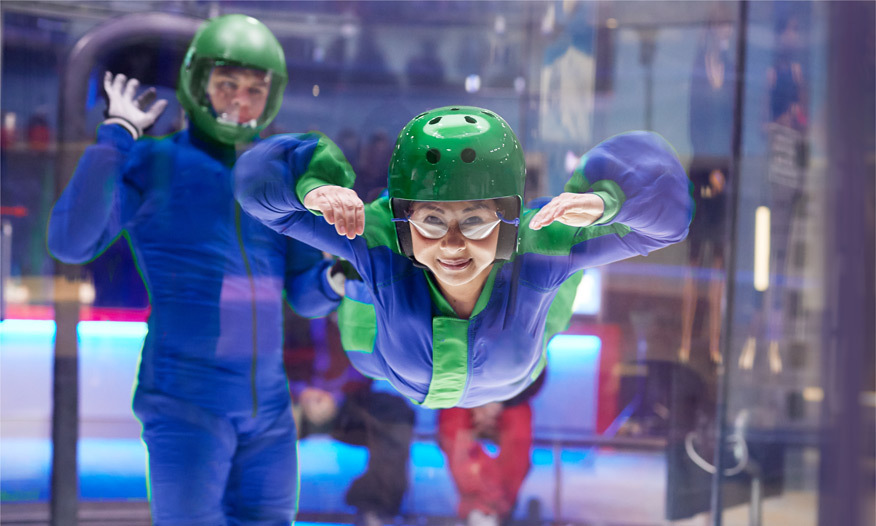GROUPON GUIDE TO CHICAGO
What is an Indoor Skydiving Simulator REALLY Like?
BY: Editors |
Skydiving Deals

Two Flights for One Person at iFLY
5520 Park Place, Rosemont • 14.3 mi
$94
iFLY

Two Flights for One Person at iFLY
800 W Scott St., Chicago • 2.2 mi
$94
iFLY

Trending
Two Flights for One at iFLY
1752 Freedom Dr., Naperville • 26.4 mi
$94
iFLY

One Skydiving Jump for One Person from Skydive Midwest
13851 56th Road, Sturtevant
27% discount_off
Skydive Midwest

Trending
Bird's-Eye View Adventure with 9,000' Heart-Pounding Tandem Skydive Experience at Chicagoland Skydiving Center
1207 Gurler Road, Rochelle
15% discount_off
Chicagoland Skydiving Center

Trending
Two Flights for One at iFLY
10-20 Borden Ave, Queens
$109
iFly New York Queens

Tandem Skydive with Instructor 14000 Feet Above Chicago!
1300 S Indiana Highway 212, Michigan City • 43.0 mi
Sale Ends 9/26
Skydive Windy City Michigan City, Indiana
Deals on Sports

Trending
Lucky Strike: Up to 73% Off Bowling + Included Shoe Rentals
735 N. Center Blvd., ROMEOVILLE • 30.0 mi
65% discount_off
Lucky Strike Bowling

Trending
Up to 73% Off Bowling with Shoe Rental Included at Bowlero
7700 47th Street, Lyons • 11.0 mi
65% discount_off
Bowlero

Golf Academy Membership for 1 or 3 Months
Sale Ends 9/26
True Motion Golf

Mas Fun at the Mas Flow 5K After Party
1419 West 18th Street, Chicago • 2.5 mi
38% discount_off
1 bought
Windy City Events Management

Trending
Enjoy ice skating & rentals for 2, 4, or 8 at Franklin Park Ice Arena
9711 Waveland Ave., Franklin Park • 13.4 mi
Sale Ends 9/26
Franklin Park Ice Arena

Up to 33% Off at Lake Katherine Nature Ctr/Botanic Garden
7402 West Lake Katherine Drive, Palos Heights • 16.7 mi
Sale Ends 9/26
Lake Katherine Nature Ctr/Botanic Garden

Experience Chicago's Essence with Wateriders’ Kayak Tours & Rentals!
500 N Kingsbury St., Chicago • 1.1 mi
Sale Ends 9/26
Wateriders Kayak Tours - Kingsbury Location

Skate Solo, Double the Fun, or Bring the Crew for a Blast
777 Kedzie Ave, Homewood • 23.2 mi
Sale Ends 9/26
Homewood Flossmoor Ice Arena

Bouldering or Ropes Courses for 2 People in Chicago!
100 South Morgan Street, Chicago • 1.5 mi
Sale Ends 9/26
Brooklyn Boulders West Loop Chicago, Illinois

Scenic 2-Hour Sail for Up To 7 Passengers on a Open Seating Catamaran
3155 South DuSable Lake Shore Drive, Chicago • 3.0 mi
Sale Ends 9/26
4 bought
1st Class Charters Chicago

Improve Your Swing with Private Golf Lessons
1130 W 37th St., Chicago • 4.0 mi
Sale Ends 9/26
Golf In Motion

Skate Lesson and Open Skate for Four to Six People
1122 E 87th St., Chicago • 10.0 mi
Sale Ends 9/26
The Rink

Tricycle Adventure: 2 or 4 Hours of Fun for One or Two Riders
1415 Ardmore Avenue, Villa Park • 18.2 mi
Sale Ends 9/26
1 bought
GlideClines | Recumbent Trikes

Chicago River Sunset or Architectural Kayaking Tour with Kayak Chicago
1220 W. LeMoyne Ave., Chicago • 2.7 mi
30% discount_off
Kayak Chicago

Experience Unlimited Adventure and Thrills with Passes!
227 Heritage Quarries Dr, Lemont • 23.6 mi
Sale Ends 9/26
The Forge Adventure Park at Lemont Quarries






